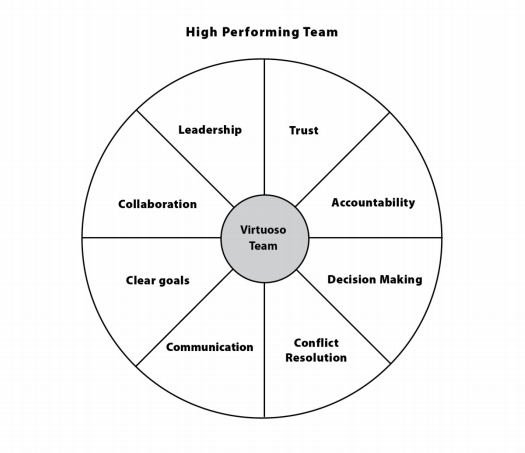People use the word “team” to mean any group of people that works for the same company, shares a common purpose, or has any degree of interdependency. Most companies don’t have teams; they have committees. Beautiful music requires more than a collection of people, however; it demands the collective efforts of professionals who devote themselves to creating an opus that no one of them working alone could achieve. True teams of every stripe share four common traits:
- Complimentary skills
- Commitment to a common purpose
- Shared goals
- Mutual interdependency and accountability
A group of average people won’t offer anything but a mediocre ability to address these four traits, however, and most companies need better. They need a team of stars—the virtuoso performers in the organization who can move change initiatives dramatically. If these virtuosos address the eight critical functions of effective team performance, you can begin to create a symphony—the beautiful harmony of exceptional performers, not the cacophony of a collection of egos:

Usually, virtuosos have made their mark through individual contributions, so collaborating may seem foreign to them—at least at first. Consequently, in team situations, they often experience anxiety from one of two main sources: not accomplishing the task or faulty interpersonal relationships.
When task issues create the problem, the team will identify difficulty with goal setting, accountability, or decision-making. They may worry about setting priorities, managing time, coordinating efforts, and distributing work. When goals are unclear or vague, or when members can’t agree on goals, strain inevitably surfaces. Share on X Therefore, setting concrete, specific, measurable goals not only contributes to task completion; it also helps to circumvent one of the main causes of the tension and sets the stage for clarifying how to distribute the work.
When faulty interpersonal relationships create the problem, members will talk about not being able to trust one another, conflict, and the inability to work cohesively. Usually, they haven’t been communicating very effectively—at least they haven’t been listening to each other too well. Some problems may be temporary, others more permanent.
Research tells us that teams go through predictable stages of development. Initially, members try to determine if and how they will fit in with this particular team. Then conflicts start to surface when members become disillusioned with the task and one another. Relationship may suffer, and negative feelings may surface in the form of impatience, rebellion, domination, and open conflict.
Eventually, successful teams gain confidence and competence, and members start to share data and to explore solutions, and things begin to run more smoothly. By then, members have begun to establish systematic approaches to decisions and to determine the ground rules for acceptable behavior.
After days or weeks, synergy starts to pay off, and openness, trust, cooperation, and maturity reign. The team begins to exhibit high flexibility and maximum use of productivity. Energy remains high because the team utilizes each member’s strengths, and competitiveness does not hamper participation. They now show the maturity to start making their own decisions to move ideas to action. Only then can the beautiful music of the virtuosos serve as the tangible reward for the members’ efforts.
Dr. Linda Henman helps CEOs and Boards of Directors set strategies, mergers and acquisitions, plan succession, and develop talent. She can be reached at linda@henmanperformancegroup.com or 636-537-3774.
Helping organizations and individuals achieve a more powerful success mindset.
Contact us to experience the dramatic growth and improvement.
Schedule a Call